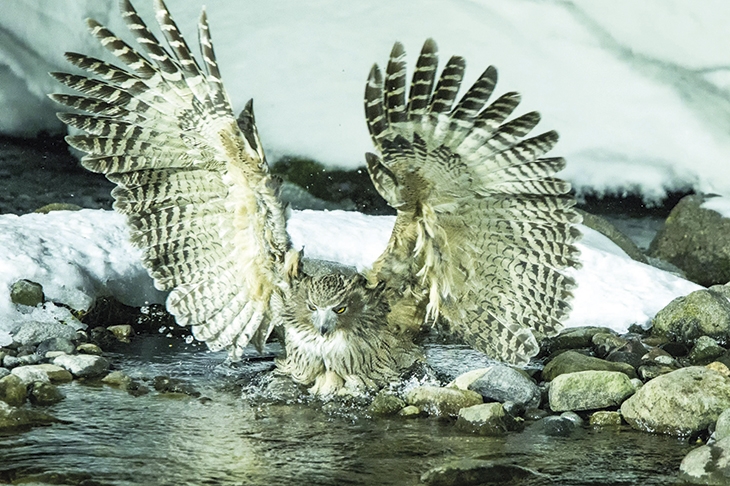The montane forests of far-eastern Russia have given rise to one of the finest nature books of recent years, The Great Soul of Siberia. In it the Korean cameraman Sooyong Park describes his quest to document the life of the region’s Amur tigers, evoking both his totem beast and its remarkable landscape in loving detail.
Jonathan Slaght is an American author, cut from the same cloth in terms of the sheer grit required to cope with the sub-zero temperatures and gloomy, snow-entombed winter woods of Siberia. Nearly 20 years ago he embarked on a similarly arduous mission, not to study the world’s biggest cat, but its largest owl, a ten-pound beast called Blakiston’s fish owl (Bubo blakistoni), named after the English naturalist Thomas Blakiston.
This magnificent monster is unusual for being largely piscivorous and for having lost the precise feather structures which enable most of its family to fly soundlessly. Since subaquatic prey cannot hear any approach, the owl has exchanged the group’s impressive winged silence for an even more dramatic woodwind thrum from its 6.5 feet wingspan.
One hunter was gored to death and half eaten by the wild boar he’d been chasing
On the Japanese island of Hokkaido, where a small, if well-documented, population of the owl also persists, it is reputed to take young deer, dogs and cats. But to the indigenous people, Blakiston’s fish owls are bathed in a semi-religious glow as guardian spirits of their homeland. Alas, the Russian communities of the Siberian forests don’t care much either for the emblematic or living creature. As a result, it is as rare and threatened as it is magnificent. Slaght’s pioneering census and ecological surveys have established a population that is marginally healthier than was previously thought, but there are still only about 2,000 breeding pairs in the world.
Siberia’s remarkably tough frontier inhabitants rely on two key occupations — forestry and hunting — and the slaughter of forest wildlife is commonplace. The animals at the sharp end of this commercialised killing include not only deer and wild boar but tigers, bears, sable, beavers and leopards. The owls face pressures from both sides of the community, especially from selective logging, which threatens their already scarce tree-hollow nest sites; and they will often be shot simply as target practice.
But at least there is a strong tradition of hospitality in Siberia. Slaght describes how he and his assistants stayed in the locals’ remote forest cabins for months on end, made welcome with copious quantities of vodka. One very isolated character, a refugee from the Vladivostok mafia, who opened his home to Slaght’s team for the longest period was convinced that beneath his mountain was an underground community of fairy folk.
While sketching in the human background to his mission, Slaght treats his companions too summarily. He lets slip that one assistant had spent 24 years down a Siberian coal mine. What on earth was that like? Alas, we never learn. And only in passing does he mention the hunter who was gored to death and half eaten by a wild boar he’d been chasing. There is also only a cursory evocation of the region in general, with its lakes, rivers and springs and its extraordinary fauna and flora. Apart from Blakiston’s fish owl, Slaght mentions barely a dozen other birds. Here is a man, one senses, with only one thing on his mind.
But he does break off to tell us about his fiancée:
My summer would be busy: I’d been dating a woman named Karen for nearly four years — we’d met in Primorye [the region with the Blakiston’s fish owls] as fellow Peace Corps volunteers — and we had an August wedding to plan. After that I would take classes at the University of Michigan to develop the skills I needed to craft a fish owl conservation strategy.
That is the extent of his beloved’s walk-on part, which perhaps best illuminates the monomaniacal genius of the author. Like Sooyong Park, Slaght has the astonishing commitment to withstand the rigours of this strange landscape but neither the language nor attentiveness to put his magnificent owl in context.






Comments